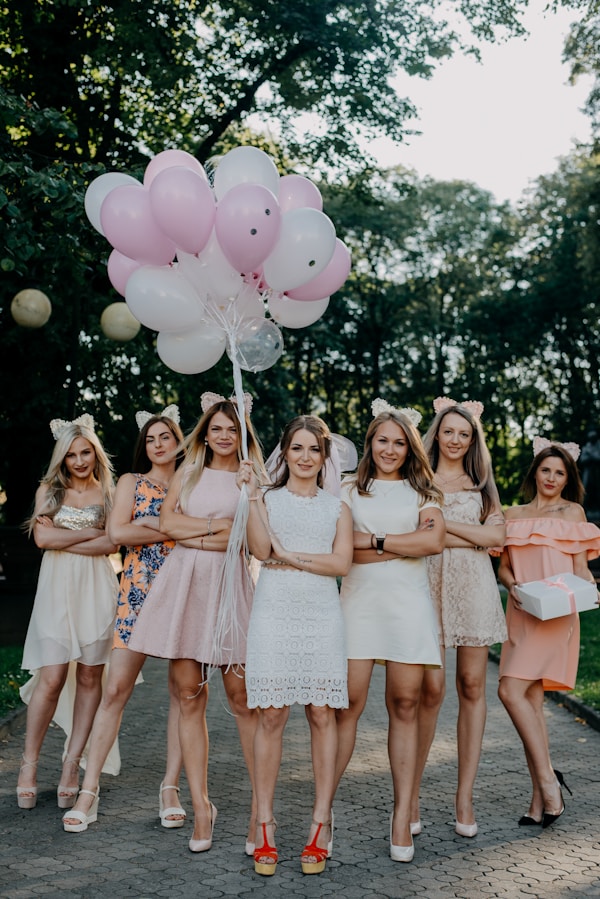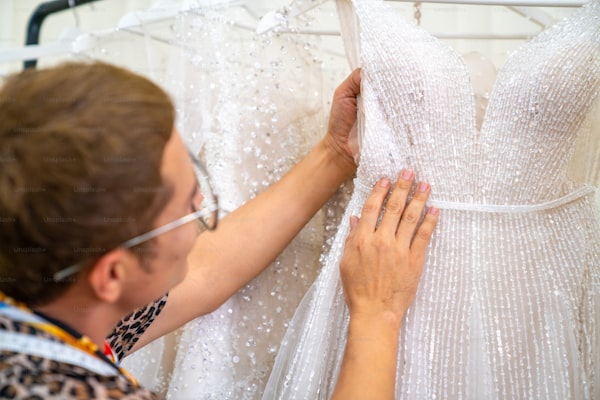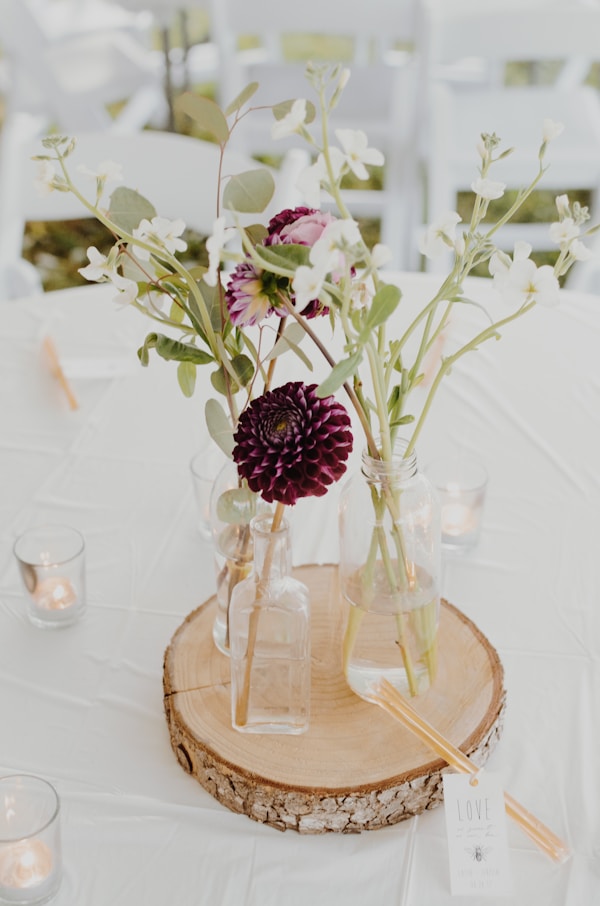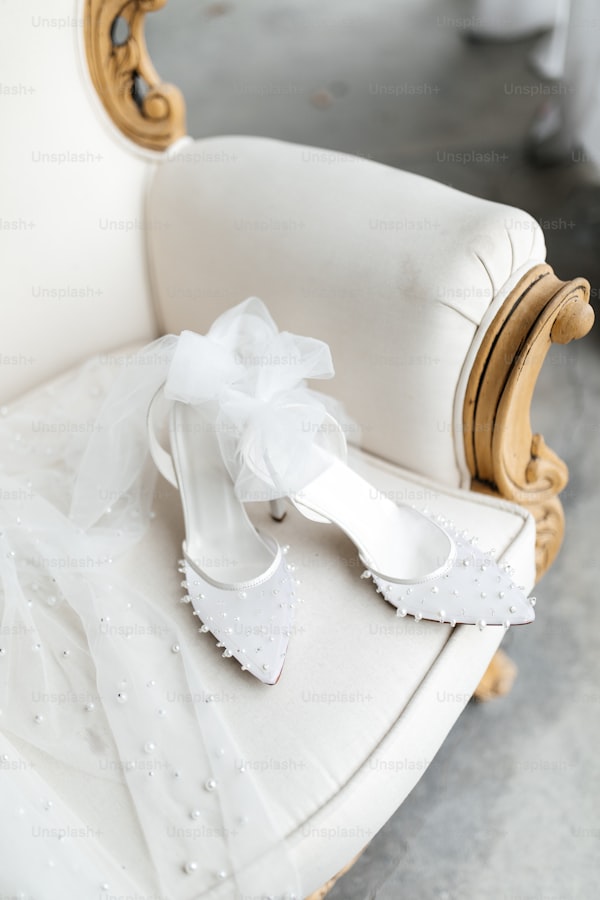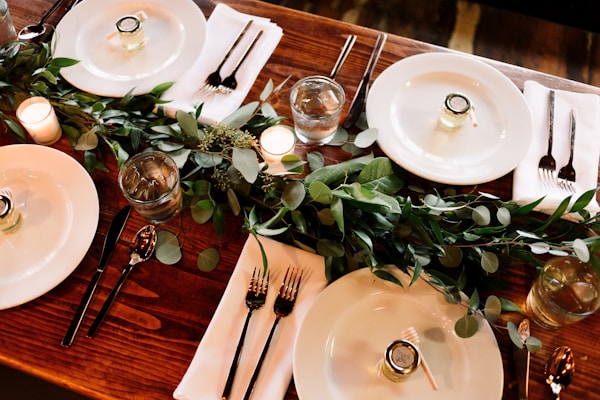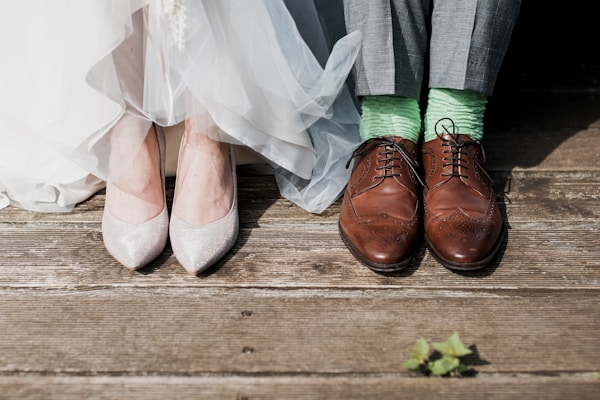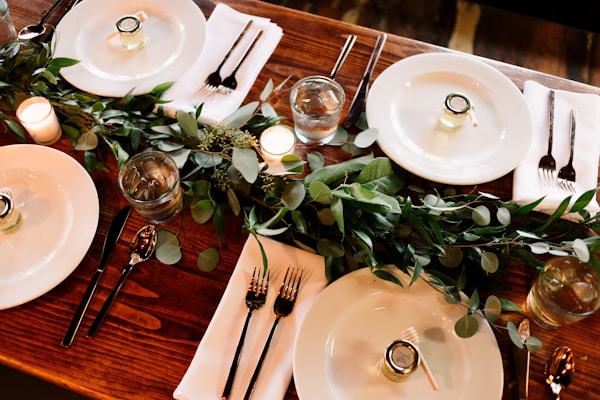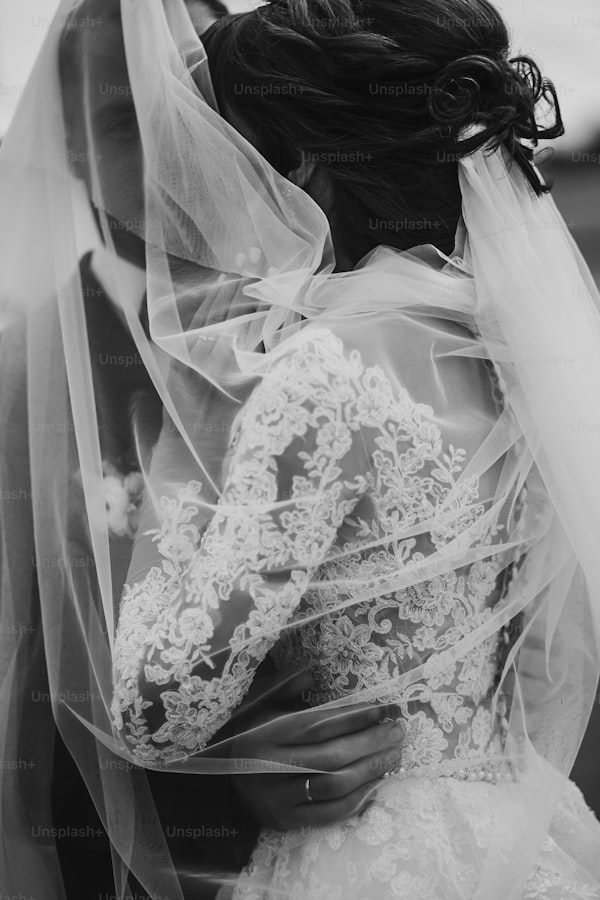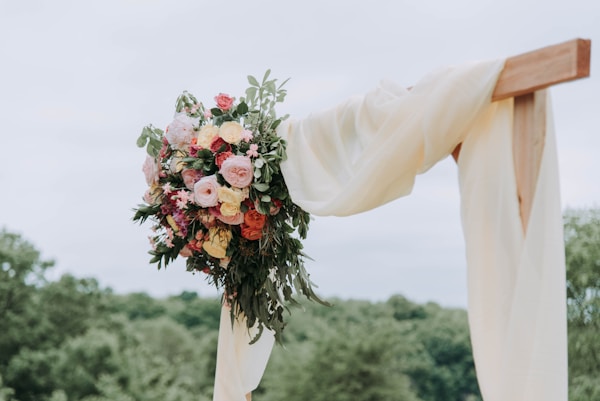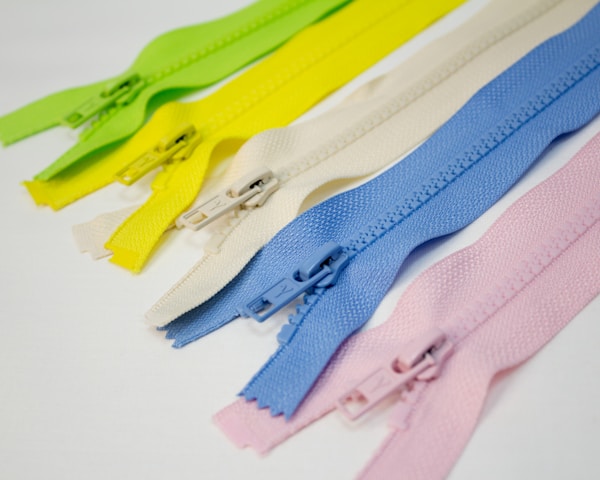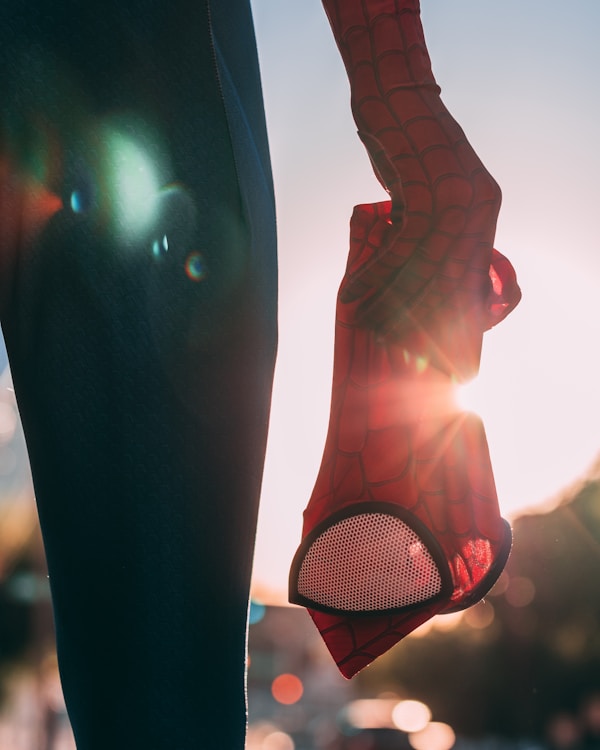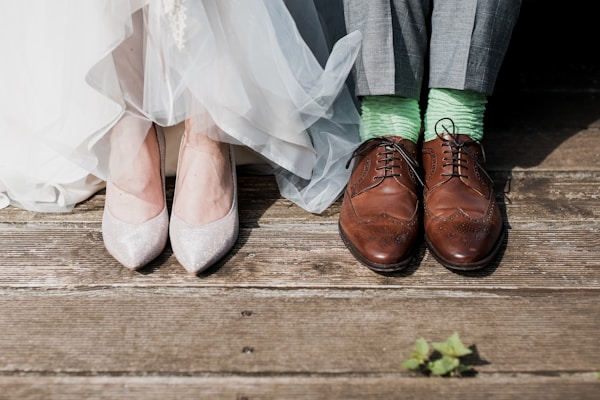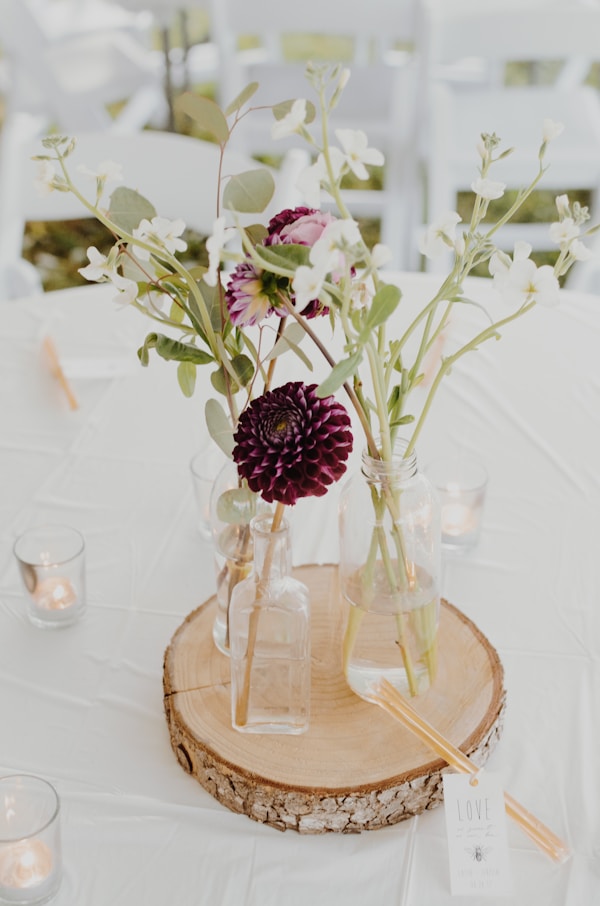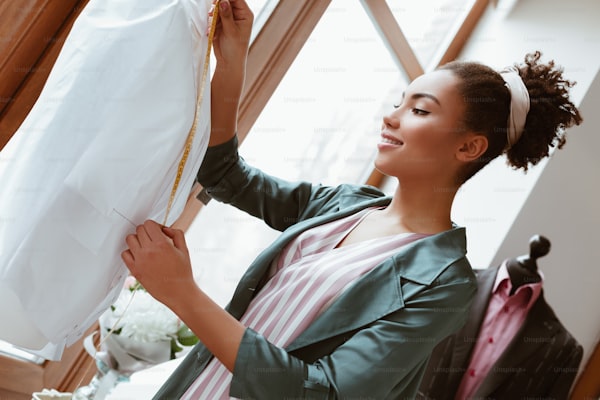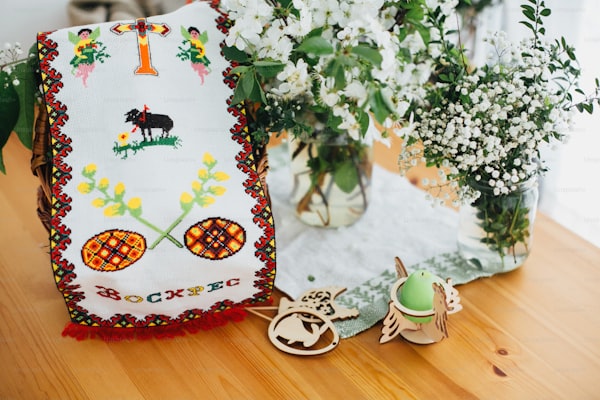Mastering Wedding Dress Alterations: A Guide for Mermaid Silhouettes
How to Manage Alterations for a Wedding Dress with a Mermaid SilhouetteA wedding dress is one of the most significant investments you’ll make for your big day. When it comes to choosing the perfect gown, the silhouette plays a vital role in how you’ll feel and look. The mermaid silhouette, characterized by its fitted bodice and flared skirt, is incredibly popular among brides seeking a blend of elegance and sensuality. However, managing alterations for a wedding dress with a mermaid silhouette is crucial for achieving that perfect fit. This article will guide you through the essential steps necessary for successful alterations.Understanding the Mermaid SilhouetteBefore diving into the alterations process, it’s important to understand what defines a mermaid silhouette. This style hugs the body from the chest to the knee before flaring out into a dramatic skirt. Because of its unique cut, alterations need to be approached with care: Body Shape Compatibility: The dress should complement your specific body shape. Comfort and Movement: Ensure that you can move fluidly while wearing the dress. Fabric Type: Consider how the fabric will respond to alterations, as some materials are easier to work with than others.Common Alteration Needs for Mermaid DressesWhile every bride's dress will require different adjustments, here are some common alteration needs for mermaid silhouettes:Alteration TypeDescriptionTaking in/Letting outAdjusting the dress to fit your body perfectly.Hemli...
Unveiling the Art: What Techniques Are Used to Create a Fitted Wedding Dress with Stretch Fabrics?
Creating a fitted wedding dress using stretch fabrics is an art that combines craftsmanship, design, and an understanding of material properties. As couples embark on their journey to one of the most important days of their lives, the choice of wedding attire plays a pivotal role, with fitted dresses gaining immense popularity due to their elegance and comfort. In this comprehensive guide, we’ll delve into the techniques employed in custom tailoring fitted wedding dresses with stretch fabrics, unraveling the secrets behind their flawless fit and stylish designs.Understanding Stretch FabricsBefore diving into the techniques, it’s essential to understand what stretch fabrics are. Stretch fabrics, made from materials like spandex, lycra, and elastane, possess elastic qualities that allow them to hug the body while providing comfort and freedom of movement. Here are some of the most common types of stretch fabrics used in wedding dresses: Jersey Chiffon Tulle CrepeAdvantages of Stretch Fabrics in Wedding DressesUsing stretch fabrics in wedding dress design offers several advantages, including:BenefitsDescriptionComfortStretch fabrics allow for unrestricted movement, which is crucial for long wedding days.Flattering FitThey contour to the body, enhancing the wearer’s silhouette.VersatilityCan be used in various dress styles, from fitted mermaid gowns to A-line silhouettes.DurabilityResistant to tears and wrinkles, making it suitable for the big day.Techniques for Creat...
How to Test the Quality of Zippers Used in Wedding Dresses: A Comprehensive Guide
Understanding Zipper Quality in Wedding DressesWhen it comes to wedding dresses, every detail matters. Among these details, zippers play a crucial role as they contribute to the overall functionality and appearance of the gown. A malfunctioning zipper can turn a dream wedding into a disaster. Therefore, understanding how to assess the quality of zippers used in wedding dresses is essential for brides-to-be and designers alike. In this article, we will cover various aspects of zipper quality, including testing methods and tips for selecting the right zipper for your wedding dress.Why Zipper Quality Matters in Wedding DressesThe zipper is an essential part of a wedding dress, enabling the garment to be easily worn while ensuring that it fits perfectly. Here are some key reasons why zipper quality is important:Durability: A wedding dress is typically worn for several hours, often during a variety of movements. A high-quality zipper can withstand this usage without malfunctioning.Aesthetic: The zipper should blend seamlessly with the design of the gown. A poorly designed zipper can detract from the beauty of the dress.Ease of Use: A smooth zipper makes the process of getting dressed, especially for a bride, much easier and stress-free.Types of Zippers Commonly Used in Wedding DressesBefore we explore how to test zipper quality, it's important to understand the types of zippers commonly found in wedding dresses:Metal Zippers: Known for their strength and durability, metal zippers ...
What are the Considerations for Designing a Wedding Dress with a Dramatic Back?
Understanding the Significance of a Dramatic Back in Wedding DressesWhen it comes to wedding dresses, brides often prioritize the aesthetic and functionality of the gown. Among the various elements that can make a wedding dress memorable, the back design stands out significantly. A dramatic back can transform a classic silhouette into a breathtaking masterpiece, captivating the attention of guests and creating enchanting photos. In this article, we’ll delve into the considerations for designing a wedding dress with a dramatic back while addressing related questions brides and designers may have.The Elements of a Dramatic Back DesignThe design of the back of a wedding dress can be as elaborate or simple as a bride wishes. However, certain elements can help create an impactful design: Neckline: The style of the neckline often dictates the back design. Low-cut backs, for example, are generally more dramatic and should align with the overall theme of the dress. Fabric:Choosing the right fabric can significantly affect the appearance of the back. Materials like lace, satin, and tulle can enhance the drama of the design. Embellishments: Details like beadings, appliques, or embroidery can elevate the back design, adding elegance and luxury. Silhouette: The overall cut of the dress influences how the back appears. A mermaid silhouette, for instance, highlights curves whereas an A-line dress offers a more romantic look.Key Considerations in Designing a Dramatic Back Weddin...
How to Maintain the Clarity of Crystals on a Wedding Dress During Cleaning
Introduction When it comes to your wedding day, every detail matters, especially the wedding dress adorned with stunning crystals. Ensuring that these crystals remain clear and brilliant is crucial for both the beauty of the dress and the memories captured in photographs. In this article, we will explore effective methods to maintain the clarity of crystals on a wedding dress during cleaning. We will also address common questions, best practices, and tips to keep these embellishments sparkling for years to come. Understanding the Materials Before diving into cleaning techniques, it is important to understand the materials involved in your wedding dress. Most wedding dresses are made from delicate fabrics like silk, satin, or tulle, and they often feature crystals made from various materials such as glass, Swarovski, or acrylic. Each type of crystal may require different cleaning methods to avoid damage while preserving clarity. Tips for Cleaning Your Wedding Dress 1. Pre-Cleaning Preparations Prior to washing your wedding dress, consider these preparatory steps: Check Care Labels: Always refer to the care label attached to your wedding dress. It often contains valuable information on cleaning methods and recommendations. Spot Test: Before applying any cleaning solution to the entire garment, conduct a spot test on a hidden area to ensure the fabric and crystals do not react negatively. Materials Needed: Gather gentle fabric soap, soft brushes, clean white cloths, and a deli...
Mastering the Art of a Structured Bodice in Lightweight Wedding Dresses
When it comes to creating the perfect wedding dress, the bodice is one of the most critical elements. For brides looking for something elegant yet comfortable, a lightweight wedding dress is an ideal choice. However, achieving a structured bodice in such a gown poses its own unique challenges. In this article, we will explore various methods used to create a structured bodice in a lightweight wedding dress. Let's dive into the details, methods, and advice that can help brides choose the right dress for their special day.Understanding the Importance of a Structured BodiceThe bodice of a wedding dress serves as the foundation for the entire garment. It not only provides support to the upper body but also plays a significant role in enhancing the bride's silhouette. A structured bodice can offer a flattering shape while ensuring the bride feels comfortable throughout her big day.In a lightweight wedding dress, achieving that structure without adding unnecessary bulk is the key. Lightweight fabrics such as chiffon, tulle, and organza are popular choices for modern wedding gowns. While these materials provide an ethereal feel, achieving a structured bodice requires clever techniques and materials.Methods to Create a Structured BodiceThere are several effective methods used by designers and seamstresses to create a structured bodice in a lightweight wedding dress. Here are some of the most popular techniques:MethodDescriptionBoningBoning involves inserting flexible strips of plasti...
Exploring the Techniques to Create a Custom Neckline on a Wedding Dress
When it comes to wedding dresses, the neckline can play a significant role in the overall aesthetics and theme of the big day. A custom neckline not only enhances the bride's silhouette but also reflects her unique style and personality. In this article, we will explore the various techniques used to create custom necklines on wedding dresses. We will delve into the types of necklines available, the methods used to design them, and considerations for brides when selecting the perfect neckline for their gown.Understanding Different Types of NecklinesBefore diving into the techniques, it's essential to understand the different types of necklines that can be customized for wedding dresses. Here are some popular options:Neckline TypeDescriptionSweetheartA heart-shaped cut that accentuates the bust area.V-NeckA neckline that goes down in a 'V' shape, elongating the silhouette.Off-the-ShoulderExposes the shoulders while providing elegant coverage around the arms.HalterWraps around the neck, leaving shoulders bare and enhancing the back.Boat NeckA wide neckline that runs horizontally across the collarbone.Illusion NecklineFeatures sheer fabric that gives the appearance of bare skin, adding drama while maintaining modesty.Techniques to Create Custom NecklinesCreating a custom neckline involves a mix of design creativity, cutting techniques, and sewing skills. Here are some techniques that dressmakers and designers use:1. DrapingDraping is a technique where the fabric is pinned, sewn,...
How to Effectively Handle Fabric Stretching During Wedding Dress Production
Producing a stunning wedding dress is a labor of love, but it comes with its fair share of challenges, one of the most significant being fabric stretching. This issue not only impacts the aesthetics of the dress but also its fit and durability. So, how do you handle fabric stretching during the production of a wedding dress? In this comprehensive guide, we will delve into effective strategies, commonly asked questions, and tips to ensure a flawless finish.Understanding Fabric StretchingBefore we can effectively manage fabric stretching, it's crucial to understand what it is and why it occurs. Fabric stretching can happen due to various factors, including: Fabric Type: Some fabrics are more prone to stretching than others. For instance, silk and satin may stretch more than cotton. Humidity and Temperature: Changes in environmental conditions can affect fabric behavior. Pattern Design: The manner in which a wedding dress is cut and assembled can impact how much stretch occurs.How Fabric Stretching Affects Wedding Dress ProductionFabric stretching can lead to several issues during the production of a wedding dress: Poor Fit: A stretched fabric can result in an ill-fitting dress that does not flatter the bride's figure. Unintended Design Changes: Stretching can alter the intended design lines and proportions of the dress. Durability Concerns: Continuous stretching may cause seams to weaken, diminishing the garment's overall longevity.Strategies for Handling Fabr...
Discovering the Best Methods to Add Embellishments to Your Wedding Dress Without the Extra Weight
Every bride wishes to look stunning on her special day, and the wedding dress plays a crucial role in achieving this look. However, many brides often face the dilemma of enhancing their wedding dress's beauty without significantly increasing its weight. Fortunately, there are various methods to add embellishments that offer the dazzling effect while ensuring comfort. In this article, we'll explore several techniques that can be utilized to beautify your wedding gown without compromising on lightweight elegance.The Importance of Lightweight EmbellishmentsWeddings are often lengthy events, and brides need to feel comfortable in their dresses throughout the day. Heavy dresses can lead to discomfort, making it challenging to enjoy the celebration. Lightweight embellishments provide a perfect solution, allowing brides to dazzle without feeling weighed down. Here are some popular methods to achieve this:1. Beading and SequinsBeading and sequins are classic choices for embellishing wedding dresses. By opting for lightweight materials, such as glass seed beads or sequins made from synthetic alternatives, you can add sparkle without adding excessive weight.Type of Bead/SequinWeightEffectGlass Seed BeadsLightweightDelicate shimmerPlastic SequinsUltra-lightBold shineMetallic BeadsModerateSophisticated glowThe combination of these embellishments can transform a simple dress into a masterpiece. Additionally, they can be sewn or glued onto the fabric in various patterns, creating a unique ...
How to Ensure the Perfect Fit of a Wedding Dress with a Halter Neckline
Choosing a wedding dress is one of the most significant decisions a bride makes, and with so many styles available, it can feel overwhelming. Among the various styles, the halter neckline has gained immense popularity for its unique appeal and elegant silhouette. However, ensuring the perfect fit for a wedding dress with a halter neckline can present specific challenges. In this article, we'll explore crucial tips, common questions, and even a helpful table to assist brides in achieving that flawless look on their special day.Understanding the Halter NecklineBefore diving into fitting techniques, it's essential to understand what a halter neckline is. A halter neckline typically features straps that wrap around the back of the neck and leave the shoulders and back exposed. This style highlights the collarbone and is flattering for various body types. However, getting the fit right is crucial for comfort and visual appeal.The Importance of a Proper FitWhen it comes to a wedding dress, especially one with a halter neckline, the fit is paramount. A well-fitted dress accentuates the bride's silhouette, while a poor fit can lead to discomfort, wardrobe malfunctions, and an unflattering appearance in photos. The halter neckline requires a precise fit around the shoulders and bust, making it imperative to consider the following factors:FactorDescriptionBody ShapeUnderstanding your body shape will help you choose a dress that flatters your unique features.MeasurementsAccurate measure...
Creating a Detachable Train for Your Wedding Dress: A Step-by-Step Guide
IntroductionWedding dresses are often the centerpiece of bridal fashion, combining elegance, style, and personal expression. One of the most sought-after trends in wedding dress design is the detachable train. The ability to have a stunning train that adds drama and length to a gown, while still being able to remove it for the reception or dancing, offers both versatility and convenience. But what are the steps for creating a detachable train for a wedding dress? In this article, we will provide a comprehensive guide to making this beautiful addition to your bridal attire. Whether you're a DIY bride or working with a tailor, our insights will help you along the way.Understanding the BasicsBefore diving into the creation process, it's important to understand a few key components of a detachable train. A well-designed train not only adds a visual element but also complements the style of your dress. Here are some factors to consider:Length and Style: Trains can range from chapel (about 1 meter long) to cathedral (over 2 meters long) lengths. Determine what suits your overall look.Attachment Mechanism: Different methods include hooks, buttons, or even ties. Choose what you feel will work best with your fabric and design.Fabric and Embellishments: Consider the fabric of both the dress and the train, as well as any embellishments like lace, sequins, or beading.Step-by-Step Guide to Create a Detachable TrainStep 1: Gather MaterialsTo create a detachable train, you'll need various m...
Mastering the Production Timeline for Your Custom Wedding Dress: A Comprehensive Guide
How Do You Manage the Production Timeline for a Custom Wedding Dress?Planning a wedding can be both exciting and overwhelming, particularly when it comes to choosing the perfect attire. One significant aspect that many brides consider is a custom wedding dress. But how do you manage the production timeline for a custom wedding dress to ensure it's ready for your big day?The Importance of a Well-Managed TimelineManaging the production timeline for a custom wedding dress is crucial to avoid unnecessary stress and last-minute hiccups. A well-planned timeline allows for adequate fittings, revisions, and adjustments, ensuring that the final dress reflects your vision perfectly. Here are some essential steps to consider in managing the timeline:1. Start EarlyBegin the process at least 6 to 12 months before your wedding date. This timeline gives you the flexibility to explore different styles, fabrics, and options without feeling rushed. It is advisable to consult multiple designers or bridal salons to get an understanding of their timelines and processes.2. Set Clear MilestonesEstablishing clear milestones throughout the process is essential. Consider breaking down the timeline into specific phases, such as:MilestoneTimelineInitial Consultation6-12 months before the weddingDesign Selection5 months before the weddingFabric and Material Sourcing4 months before the weddingFirst Fitting3 months before the weddingSecond Fitting2 months before the weddingFinal Fitting1 month before the w...
Discover the Secrets Behind Creating a Flowy Look in Chiffon Wedding Dresses
Your wedding day is one of the most momentous occasions in your life, and selecting the perfect wedding dress is crucial. Chiffon wedding dresses are renowned for their ethereal and flowy appearance, which gives brides a light, romantic look. If you're wondering, what techniques are used to create a flowy look in a wedding dress with chiffon? you’re in the right place! This article will explore various techniques to achieve that dreamy silhouette.The Allure of Chiffon Chiffon is a lightweight, sheer fabric made from silk, polyester, or a blend of these materials. It's known for its softness and airy quality. Brides often choose chiffon for its graceful draping ability and flattering fit. However, creating that perfect flowy look involves more than just the fabric itself. Here are some key techniques that designers and dressmakers use.1. Layering for Depth and Movement One of the most effective techniques in creating a flowy look is layering. Designers often use multiple layers of chiffon to build a fuller skirt and add depth to the overall silhouette. Each layer helps the dress move gracefully with the bride’s every step. When layered correctly, chiffon can create a stunning waterfall effect as it cascades down, enhancing the dress's lightness and mobility.Advantages of Layering ChiffonDescriptionEnhanced MovementThe layers move fluidly, providing a whimsical appearance.Increased FullnessMultiple layers can create a fuller silhouette without added weight.Depth and DimensionL...
Effective Strategies to Prevent Bead Discoloration on a Wedding Dress
Your Dream Wedding Dress: Preserving Its BeautyA wedding dress is often one of the most significant purchases in a bride's life. With intricate details and beautiful embellishments such as beading, maintaining the pristine condition of this garment is essential. One of the common concerns brides may face is bead discoloration over time. In this article, we will explore how you can prevent bead discoloration on a wedding dress and ensure it remains as stunning as the day you wore it.Understanding Bead DiscolorationBead discoloration can occur due to various factors including exposure to moisture, body oils, makeup, and environmental pollutants. This discoloration can detract from the beauty of the dress, leaving brides worrying about their wedding day memories. To effectively combat this issue, a proactive approach is necessary.1. Choose the Right BeadsWhen selecting your wedding dress, consider the type of beads used in the design. Glass beads, for instance, typically withstand discoloration better than plastic beads. Additionally, crystal beads often offer a more durable finish compared to other materials. Consult your designer regarding the choice of beads and their longevity.Preventative Measures to Protect Your DressImplementing certain protective measures can significantly reduce the risk of bead discoloration. Here are some effective methods:2. Store ProperlyAfter your wedding, proper storage is crucial. Avoid hanging your dress on a hanger for long durations, as this c...
Mastering the Art of Invisible Zippers: Techniques for Wedding Dress Perfection
IntroductionWhen it comes to wedding dress design, every detail matters—especially closures. Among the various fasteners available, the invisible zipper has gained popularity for its sleek and seamless appearance. But what methods are used to create an invisible zipper on a wedding dress? In this article, we'll dive into the techniques and tips for perfecting this essential component of bridal wear, ensuring that your gown is both beautiful and functional.Understanding Invisible ZippersBefore diving into the methods, it's essential to understand what an invisible zipper is. Typically made from a lightweight fabric, invisible zippers are designed to blend in with the seam of the garment, making them almost undetectable. This feature adds sophistication to the gown while allowing for a fitted look that is appealing to brides. Below are some basic characteristics:CharacteristicDescriptionMaterialLightweight and flexibleAppearanceSeamless and discreetUsageCommonly used for formal wear and bridal gownsInstallation DifficultyRequires precision and techniqueMethods for Creating an Invisible Zipper on a Wedding DressThere are several methods employed by designers and seamstresses to create an invisible zipper on a wedding dress. Let's explore these techniques step by step.1. Choosing the Right ZipperThe first step in creating a flawless invisible zipper is to select the appropriate one. Invisible zippers come in various lengths and colors. It's crucial to match the zipper to the fabr...
Achieving a Structured Look in a Wedding Dress with Soft Fabrics: A Complete Guide
IntroductionWhen planning your wedding, choosing the perfect wedding dress is one of the most significant decisions you will make. Many brides dream of a beautiful gown that has a structured silhouette while being made from soft, flowing fabrics. But how do you achieve that perfect balance? This article will guide you through the various aspects of selecting and styling a wedding dress that combines structure with the delicate softness of fabric.Understanding Soft FabricsSoft fabrics such as chiffon, tulle, satin, and lace are often favored for their romantic and ethereal qualities. However, these materials can sometimes lack the structure needed to create a striking wedding dress silhouette. To achieve that structured look, it’s essential to understand the properties of these fabrics and how they can be manipulated to enhance your gown design.Types of Soft FabricsFabric TypeCharacteristicsChiffonLightweight, sheer, and flowing; drapes beautifully but can be prone to wrinkling.TulleStiff and net-like; creates volume and can be layered for additional structure.SatinLuxurious and smooth; has a bit of weight, which adds structure while retaining a soft appearance.LaceDelicate and textured; can add decorative elements and contrast to a structured design.Creating Structure with Soft FabricsIf you're wondering how to achieve a structured look in a wedding dress with soft fabrics, there are several techniques to consider. Here are some of the most effective methods:1. Layering Fabri...
Mastering the Art of Wedding Dress Alterations: Handling Delicate Lace with Care
How Do You Handle Delicate Lace When Making Alterations to a Wedding Dress?Altering a wedding dress can be a daunting task, especially when it involves the intricate art of handling delicate lace. Lace is a beautiful fabric that adds elegance and charm to any bridal gown, but it's also a material that requires special care and attention. If you're wondering, how do you handle delicate lace when making alterations to a wedding dress?, you've come to the right place. This article will provide you with comprehensive insights into managing lace during wedding dress alterations, along with tips and techniques to ensure a flawless finish.The Importance of Proper Handling of LaceLace can be fragile and might easily fray or tear if not treated with the utmost care. Here are several reasons why proper handling of lace is crucial during wedding dress alterations: Preservation of Design: Lace often contributes significantly to the overall aesthetic of the dress. Damaging it could compromise the design. Fit Issues: Poor handling can create uneven seams, leading to an uncomfortable fit for the bride. Longevity: Taking care during alterations ensures that the dress can be cherished for years to come, whether for future events or as a keepsake.Tools and Materials NeededBefore diving into the alteration process, it's essential to gather the right tools and materials to minimize damage to the delicate lace. Here’s a checklist of what you'll need:ToolsDescriptionSharp Fabric ScissorsU...
Ultimate Guide: Best Practices for Storing Wedding Dresses to Prevent Yellowing
Preserving Your Cherished Wedding DressYour wedding dress is one of the most important garments you will ever own. It symbolizes joy, love, and one of the most significant days of your life. However, if not stored properly, it can succumb to yellowing over time, diminishing its beauty and sentimental value. In this article, we will explore the best practices for storing wedding dresses to prevent yellowing, ensuring that your dress remains as pristine as the day you wore it.Understanding Yellowing in Wedding DressesBefore delving into the best storage practices, it's essential to understand what causes yellowing in wedding dresses. Natural fibers, like silk and linen, are particularly susceptible to yellowing due to factors like exposure to light, moisture, and even body oils from when the dress was worn. Over time, these elements can lead to irreversible discoloration.Common Causes of YellowingCauseDescriptionStorage ConditionsExcessive light and humidity can accelerate yellowing.Detergents and ChemicalsResidues from detergents or sprays can react with the fabric.Body Oils and PerfumeContact with skin oils and cosmetics can stain the fabric.Best Practices for Storing Wedding DressesNow that we understand what contributes to yellowing, let's explore effective strategies to store your wedding dress correctly.1. Clean Your Dress Before StoringBefore storage, have your wedding dress professionally cleaned to remove any stains, oils, or residues that can contribute to yellowing. ...
How to Secure a Wedding Dress Train to Avoid Tripping: Tips and Techniques
Understanding the Importance of a Well-Secured Wedding Dress TrainYour wedding day is one of the most important days of your life, and as a bride, you want to look stunning. One of the most iconic elements of any wedding dress is the train. However, a long train can also lead to unexpected challenges, such as tripping or tangling. In this article, we will explore various methods to secure your wedding dress train effectively, ensuring you can move gracefully throughout your special day.Common Concerns about Wedding Dress TrainsWhen planning your wedding, securing your dress train is essential. Here are some common concerns brides may have: How can I prevent my train from dragging on the ground? What methods are available to hold my train up during the ceremony? Can I attach my train to my dress securely? Should I consider specific accessories for train management?Methods to Secure Your Wedding Dress TrainThere are numerous techniques to ensure your wedding dress train is secured. Here are the most effective methods:1. Bustle TechniqueA bustle is a popular solution for securing a wedding dress train. By gathering the train and fastening it to the dress, you can effectively lift it off the ground. Here’s a simple guide to creating a bustle: Identify Bustle Points: Before the wedding, take your dress to a tailor to identify where the bustle points will be sewn. Choose the Bustle Style: There are various bustle styles, such as American, French, and Ballroom. Dis...
Unveiling the Art of Embroidery: Techniques for Applying Embroidery on a Wedding Dress
The Allure of Embroidery in Wedding AttireEmbroidery is a timeless decorative technique that adds an enchanting touch to wedding dresses. For brides seeking to personalize their gowns, understanding the various techniques used to apply embroidery can greatly influence their design choices. This article aims to explore the different techniques used to apply embroidery on a wedding dress, the types of embroidery styles available, and valuable tips for selecting the perfect embellishments for your big day.Understanding Embroidery TechniquesEmbroidery can be applied using a variety of techniques, each offering unique textures and visual effects. Here are some popular methods that you might consider:TechniqueDescriptionHand EmbroideryA traditional method involving skilled artisans stitching designs manually onto the fabric, allowing for intricate and personalized patterns.Machine EmbroideryUtilizes sewing machines to create designs rapidly and uniformly, often used for larger batches or intricate patterns that require precision.GoldworkA specialized technique using gold thread to create luxurious and eye-catching designs, commonly seen in high-end bridal wear.AppliquéThis method involves sewing one piece of fabric onto another, allowing for layered designs and diverse textures.Bead EmbroideryIncorporates beads along with embroidery to add sparkle and dimension to the fabric, enhancing the gown's overall appeal.Choosing the Right Embroidery Style for Your Wedding DressWhen selectin...
